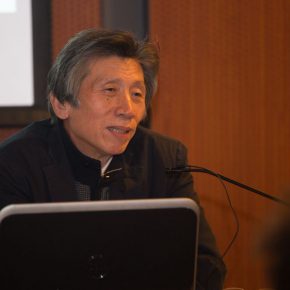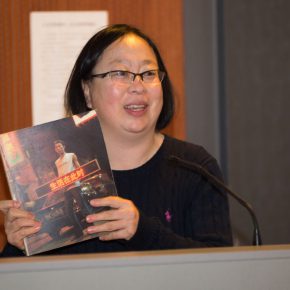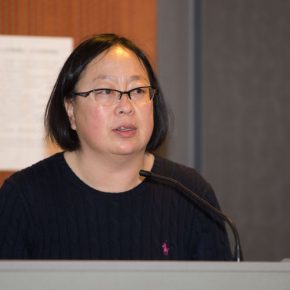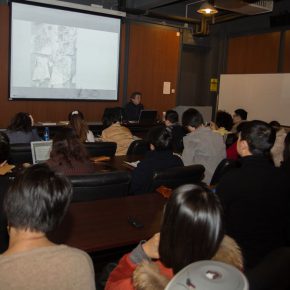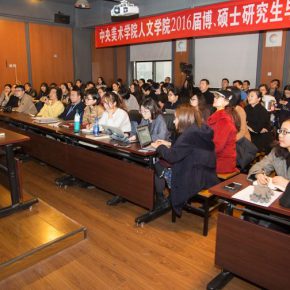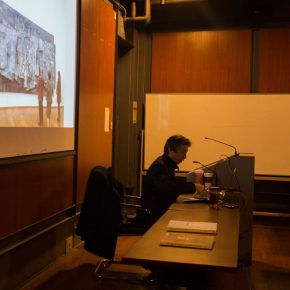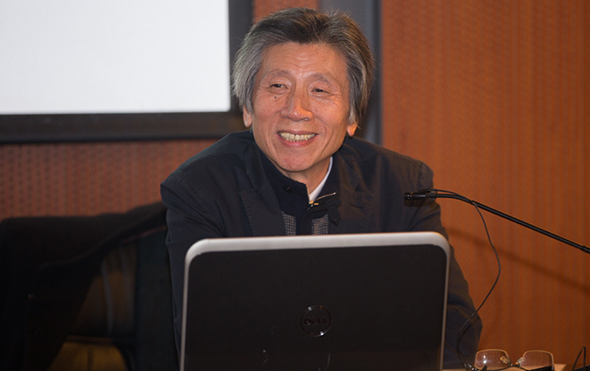
At 14:30 on November 17, 2016, President of CAFA Fan Di’an brought an academic report to the students at Room A306 in Building 14, CAFA. It is one of the lectures among the postgraduate courses given by Prof. Song Xiaoxia from CAFA. Prof. Song Xiaoxia said at the opening that: “This course focused on the academic issue of the relationship between contemporary art and the contemporary China as well as the world. How does contemporary China construct its own cultural subjectivity in the context of cultural interaction in a global perspective? Prof. Fan Di’an has been a thoughtful practitioner since the 1980s.
At the beginning of the lecture, Fan Di’an said that: “Prof. Song Xiaoxia directs the course of ‘Contemporary Art Studies in a Global Perspective’ and the open teaching style offers an important vision and perspective to us standing in the new collision, agitation and fusion of global culture. For the engagement in both the artistic practice and theoretical research, the vision determines the pattern, and the perspective determines the method.” Only standing on the coordinates of the times, striving to have a macro grasping of the cultural process and artistic phenomena, people can form the pattern of the making of art and articles. Each person’s research is inseparable from the overall academic pattern, so that only when the own pattern and academic pattern form the isomorphism, it has a clear and rational understanding; and seen from a different perspective, different perspectives will form different judgments, although it is difficult to accurately grasp the large entirety, we need to get rid of the narrow and have a more accurate perspective to find a solution for the problem.
“Cultural Consciousness” is a big topic and also a new topic. President Fan said that, “The purpose of cultural consciousness is to build the cultural China, allowing our culture better developed, to have the own starting point and discourse style in world exchanges. Fan Di’an first started from the exhibition of Kiefer which was going to be held at CAFA Art Museum: “Kiefer has a lot of works about clothes, when we search from Kiefer’s works of clothes and the medium, we will find that the creative motive of the artist, and the relationship between concepts and memories. It is the reminiscent topic that reveals that he is an artist of historical sense, and his concern for the existence of life.” Thus it can be traced to Kiefer’s teacher Beuys and many other Western art masters, as well as Chinese artists such as Sui Jianguo, Wang Tiande, Yin Xiuzhen, who are engaged in the creation of “cloths”, and we can see the “conography” of “clothing”, which can be specially researched. Fan believes that contemporary art research is different in form, but some motifs, media and form are the starting point of the study.
Then, Fan Di’an quote Arthur Danto’s sentence “The combination of essentialism and historicism helps the definition of immediate condition of visual art” to point out that essentialism and historicism almost constitute the coordinates of academic research, the combination of the two theories both see the value of things, and also the historical relevance of things, it particularly needs the combination of the two to discuss Chinese art. Based on this thinking, Prof. Fan had a discussion on “cultural consciousness” from the following aspects.
The Occurrence of Chinese Contemporary Art
From Picasso’s “Les Demoiselles d’ Avignon”, to “Le déjeuner sur l'herbe” by Manet, “The Painters Studio: A Real Allegory” by Gustave Courbet, “et in arcadia ego” by Poussin, the emergence of modernism has not been positioned yet, and when did Chinese contemporary start? Prof. Fan said that, “It requires us to start from the perspective of documental research and the background of cultural exchange.” “It can be said that Chinese contemporary art started from 1989, or 1985, but we should pay attention to that the prelude of the evolution of Chinese art and the germination of new ideas started in 1979.” “Perhaps some people might question the relationship with contemporary art, but the germination of new artistic forms can’t be separated from the context, taking the study of the May Fourth Movement as an example, a lot of things happened before the May Fourth Movement, such as the new culture and even people began to think about changes in the late Qing Dynasty. If there was not the late Qing Dynasty, there was not the May Fourth Movement. If the reform and opening did not start a new prelude of the ideology and culture, there was not the contemporary art.
International Exchange of Contemporary Art
“Chinese artists moved towards the overseas stage from the ‘Magiciens de la Terre’, the Venice Biennale, Documenda, to Art Basel, but we have been in a chosen position for a long time,” Fan Di’an said that, “It is almost a normal historical experience, a country started from the closed to the open, from being misunderstood to be cognized, there was a seesaw process, and now we are located in the stage of involving, blending, being intertwined, artistic convection.” In this case, we must grasp the common topic and cultural context. Take the exhibition planning as an example, the mutual cooperation of curators and art institutions is the first, only when the inner and outer eyes meet, the image of Chinese art will be clear; secondly, in the cultural contexts of different periods, the common topic is not same, but China and the West pay more and more attention to the effectiveness of the current themes, we can find a common topic from the historical perspective, art ontology (media, way, etc.), the perspective of social culture (urbanization, rural changes, social groups, women) and so on.
The Chinese Way of Contemporary Art
In the view of Prof. Fan, the art concept formed by the Chinese tradition is an important resource for artistic creation today, and tradition is a support of contemporary art creation; we have a rich ancient tradition, and also a rich art tradition since the modern, namely the cultural realistic spirit. He said that, “When it comes to contemporary art, it can’t simply cut traditions, and many artists also focus on the traditional impetus for contemporary art creation, for example, Xu Bing often talks about the tradition supporting his artistic innovation, sometimes technically, sometimes the macroscopic realistic concern. Seen from the perspective of the world, since the post-modernism, we see the gap between tradition and contemporary is gradually filled and level up, and the tradition is connected with the contemporary by different ways. This is an important method for us to discuss the vision and perspective.”
In terms of visual style and the studying of the nature of things, President Fan believes that any visual thinking must always be implemented in the way of expression. He listed the works by contemporary artists, including Wu Guanzhong, Zhan Wang, Yu Hong and Liu Xiaodong, to illustrate the real concern of art. As the president of CAFA, he said that, CAFA had been focusing on the organizing of the collective thematic creative research events in the past two years, which include the promoting of teachers and students to deepen into lives, researching and sketching, in order to lead the teachers and students to concern for reality. For example, under the leadership of Zhang Lujiang, a group of postgraduate students from the Department of Fundamental Education for Plastic Arts re-took the Long March, painted a large number of recipes of the Red Army during the period of Long March, and the works were full of vivid feelings from the historical scene. In recent years, many teachers’ solo exhibition and group exhibitions were held, which also made achievements in the aspect of the studying of the nature of things.
Have a cultural self-confidence and the discourse construction of “General Secretary Xi Jinping who proposes that, ‘We must adhere to the self-confidence of road, theory, and system, and the most fundamental one is cultural self-confidence, which is a more basic, broader, and deeper self-confidence.’ It indicates a direction for us to have a firm cultural belief in the field of art.” President Fan believes that the international environment and cultural patterns have undergone profound changes along with the social development, and we need to form a consensus on cultural self-confidence in such circumstances, he said: “Our nation has experienced a century of fighting, struggling and constructing, and now we must have cultural self-confidence.” President Fan pointed out that the culture included two aspects, firstly it was cultural heritage, namely the excellent, extensive and profound traditional culture, which is the mother of our development and the deepest spiritual pursuit; secondly, the patriotic and pioneering spirit of the times formed since the twentieth century.
At the end of the lecture, Fan Di’an said that: “It seems that cultural self-confidence is a big topic, but it is necessary to implement it in our practice of art, the art is tension and vital only when it is of cultural confidence. From the shape to experience, from the macro to the micro, and then the artistic language, it is inseparable from the enhancement of the cultural soft power and cultural self-confidence.”
Text by Zhong Yuwei, translated by Chen Peihua and edited by Sue/CAFA ART INFO
Photo by Hu Sichen/CAFA ART INFO


